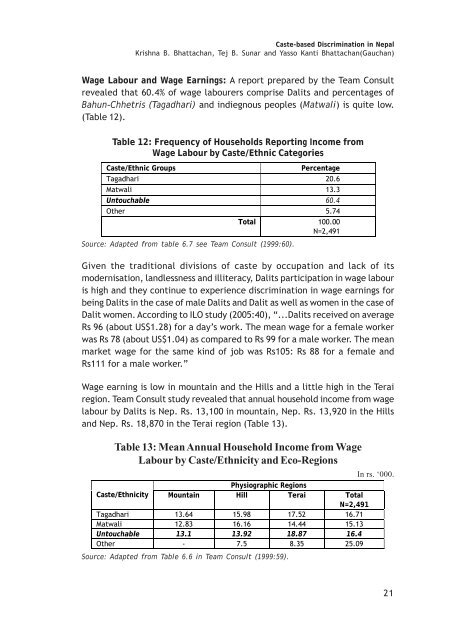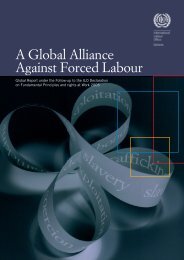Caste-based discrimination in Nepal - International Dalit Solidarity ...
Caste-based discrimination in Nepal - International Dalit Solidarity ...
Caste-based discrimination in Nepal - International Dalit Solidarity ...
Create successful ePaper yourself
Turn your PDF publications into a flip-book with our unique Google optimized e-Paper software.
<strong>Caste</strong>-<strong>based</strong> Discrim<strong>in</strong>ation <strong>in</strong> <strong>Nepal</strong><br />
Krishna B. Bhattachan, Tej B. Sunar and Yasso Kanti Bhattachan(Gauchan)<br />
Wage Labour and Wage Earn<strong>in</strong>gs: A report prepared by the Team Consult<br />
revealed that 60.4% of wage labourers comprise <strong>Dalit</strong>s and percentages of<br />
Bahun-Chhetris (Tagadhari) and <strong>in</strong>diegnous peoples (Matwali) is quite low.<br />
(Table 12).<br />
Table 12: Frequency of Households Report<strong>in</strong>g Income from<br />
Wage Labour by <strong>Caste</strong>/Ethnic Categories<br />
<strong>Caste</strong>/Ethnic Groups<br />
Percentage<br />
Tagadhari 20.6<br />
Matwali 13.3<br />
Untouchable 60.4<br />
Other 5.74<br />
Total 100.00<br />
N=2,491<br />
Source: Adapted from table 6.7 see Team Consult (1999:60).<br />
Given the traditional divisions of caste by occupation and lack of its<br />
modernisation, landlessness and illiteracy, <strong>Dalit</strong>s participation <strong>in</strong> wage labour<br />
is high and they cont<strong>in</strong>ue to experience <strong>discrim<strong>in</strong>ation</strong> <strong>in</strong> wage earn<strong>in</strong>gs for<br />
be<strong>in</strong>g <strong>Dalit</strong>s <strong>in</strong> the case of male <strong>Dalit</strong>s and <strong>Dalit</strong> as well as women <strong>in</strong> the case of<br />
<strong>Dalit</strong> women. Accord<strong>in</strong>g to ILO study (2005:40), “...<strong>Dalit</strong>s received on average<br />
Rs 96 (about US$1.28) for a day’s work. The mean wage for a female worker<br />
was Rs 78 (about US$1.04) as compared to Rs 99 for a male worker. The mean<br />
market wage for the same k<strong>in</strong>d of job was Rs105: Rs 88 for a female and<br />
Rs111 for a male worker.”<br />
Wage earn<strong>in</strong>g is low <strong>in</strong> mounta<strong>in</strong> and the Hills and a little high <strong>in</strong> the Terai<br />
region. Team Consult study revealed that annual household <strong>in</strong>come from wage<br />
labour by <strong>Dalit</strong>s is Nep. Rs. 13,100 <strong>in</strong> mounta<strong>in</strong>, Nep. Rs. 13,920 <strong>in</strong> the Hills<br />
and Nep. Rs. 18,870 <strong>in</strong> the Terai region (Table 13).<br />
Table 13: Mean Annual Household Income from Wage<br />
Labour by <strong>Caste</strong>/Ethnicity and Eco-Regions<br />
In rs. ‘000.<br />
Physiographic Regions<br />
<strong>Caste</strong>/Ethnicity Mounta<strong>in</strong> Hill Terai Total<br />
N=2,491<br />
Tagadhari 13.64 15.98 17.52 16.71<br />
Matwali 12.83 16.16 14.44 15.13<br />
Untouchable 13.1 13.92 18.87 16.4<br />
Other - 7.5 8.35 25.09<br />
Source: Adapted from Table 6.6 <strong>in</strong> Team Consult (1999:59).<br />
21

















